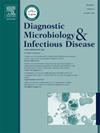Evaluating saliva for SARS-CoV-2 detection: A practical alternative
IF 2.1
4区 医学
Q3 INFECTIOUS DISEASES
Diagnostic microbiology and infectious disease
Pub Date : 2025-05-14
DOI:10.1016/j.diagmicrobio.2025.116902
引用次数: 0
Abstract
Accurate and rapid detection of SARS-CoV-2 is critical for controlling the spread of COVID-19, particularly among asymptomatic carriers. This study evaluates saliva as a viable alternative to nasopharyngeal swabs (NPS) for SARS-CoV-2 detection using real-time RT-PCR and rapid antigen testing (RAT). A total of 201 paired NPS and saliva samples were collected and analyzed. Saliva-based RT-PCR demonstrated 100 % (95 % CI, 94.64 % to 100 %) sensitivity and 97.10 % (95 % CI, 92.74 % to 99.2 %) specificity, with an overall accuracy of 98.05 % (95 % CI, 95.44 % to 99.47 %), closely aligning with NPS results. Similarly, saliva-based RAT exhibited comparable diagnostic performance to NPS-based RAT, with sensitivity and specificity of 100 % (95 % CI 90.51-100 %) and 99.39 % (95 % CI 96.67-99.98 %) respectively. When compared to the gold standard NPS real-time RT-PCR, the sensitivity of RAT using saliva and NPS samples was found to be 69.07 % (95 % CI, 58.88 % to 78.08 %) and 69.79 % (95 % CI, 59.57 % to 78.75 %), respectively. Notably, for cases with cycle threshold (Ct) values ≤30, saliva RAT achieved 97.30 % (95 % CI, 85.84 % to 99.93 %) sensitivity, highlighting its effectiveness in detecting infectious cases. Therefore, saliva offers a practical alternative to NPS for large-scale screening, particularly in resource-limited settings, due to its non-invasive nature, ease of self-collection, and high diagnostic accuracy
评估唾液检测SARS-CoV-2:一种实用的替代方案
准确和快速检测SARS-CoV-2对于控制COVID-19的传播至关重要,特别是在无症状携带者中。本研究评估了唾液作为鼻咽拭子(NPS)检测SARS-CoV-2的可行替代品,采用实时RT-PCR和快速抗原检测(RAT)。共收集和分析201份配对NPS和唾液样本。基于唾液的RT-PCR显示出100% (95% CI, 94.64% ~ 100%)的敏感性和97.10% (95% CI, 92.74% ~ 99.2%)的特异性,总体准确性为98.05% (95% CI, 95.44% ~ 99.47%),与NPS结果密切相关。同样,基于唾液的RAT的诊断性能与基于nps的RAT相当,灵敏度和特异性分别为100% (95% CI 90.51- 100%)和99.39% (95% CI 96.67- 99.98%)。与金标准NPS实时RT-PCR相比,使用唾液和NPS样品的RAT的灵敏度分别为69.07% (95% CI, 58.88% ~ 78.08%)和69.79% (95% CI, 59.57% ~ 78.75%)。值得注意的是,对于周期阈值(Ct)≤30的病例,唾液RAT的敏感性达到97.30% (95% CI, 85.84% ~ 99.93%),显示了其检测感染性病例的有效性。因此,由于唾液具有非侵入性、易于自我收集和诊断准确性高的特点,因此在大规模筛查中,特别是在资源有限的情况下,唾液提供了一种实用的替代NPS的方法
本文章由计算机程序翻译,如有差异,请以英文原文为准。
求助全文
约1分钟内获得全文
求助全文
来源期刊
CiteScore
5.30
自引率
3.40%
发文量
149
审稿时长
56 days
期刊介绍:
Diagnostic Microbiology and Infectious Disease keeps you informed of the latest developments in clinical microbiology and the diagnosis and treatment of infectious diseases. Packed with rigorously peer-reviewed articles and studies in bacteriology, immunology, immunoserology, infectious diseases, mycology, parasitology, and virology, the journal examines new procedures, unusual cases, controversial issues, and important new literature. Diagnostic Microbiology and Infectious Disease distinguished independent editorial board, consisting of experts from many medical specialties, ensures you extensive and authoritative coverage.

 求助内容:
求助内容: 应助结果提醒方式:
应助结果提醒方式:


